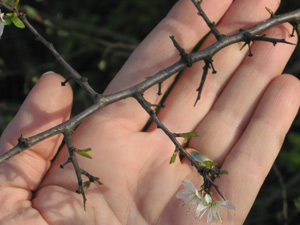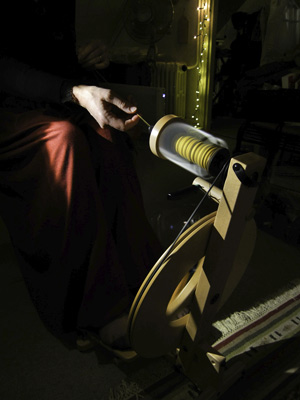The Archives
Return to the
Archive directory
Return to the
Now spinning
page
Winter into Spring 2013
You have to look closely, but it appears that spring really, truly will arrive here -- any moment now! Buds are happening (not actually opening yet, but clearly getting into position for the Big Burst into Bloom). The daffodils don't yet have blossoms, but they've timidly pushed up some leaves, and other bulbs are heaving the earth above them, so they're sure to emerge sometime soon.
I am SO ready for a change in season!
Despite several left-hand mishaps (including the jammed finger, a pretty bad scrape and a nasty burn), I've been limping my way through new projects in my woodworking corner. ...That's another sign of spring. :-)
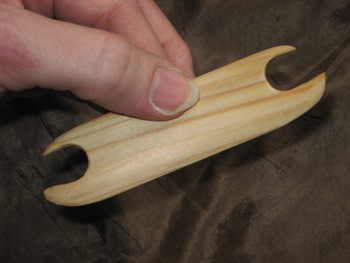
This one (right) is the one that pleases me most: it's the newest, smallest size of the shuttles I've been making for the past year. This one is 4 inches long, the perfect size for weaving narrow bands. It's a pleasure to hold, and it makes me very happy.
The shuttles were supposed to go up on this website late last year, but I kept selling all the ones I had on hand and wanted to have at least a few "in stock" before announcing them to the world. The time has come for them to emerge into the light.
You'll now find a small selection of shuttle offerings in the Products section of this website. To go directly to the shuttles, just click here.
And what's up next?? When my hand improves enough to allow it, the hardwood shuttles will come online, as will the longer ones. For the moment, though, enjoy these. The size is just right, and the pine is very fine. :-)
This is a sombre, pensive note. Today I'm seeing things through thoughtful eyes. I learned yesterday that I have lost a friend, and I'm suddenly flooded with visions and memories: the sound of her laughter; cappuccino on a Saturday morning in her vividly red coffee cups; her brisk way of tidying things magically into an array of beauty and order; the smell of pines outside her house; the way she would scold me, then ask the pertinent question, then suddenly put her finger on the heart of an issue.
She was the one who taught me to spin. She would deny that, I think, because she didn't consider herself a teacher -- but she showed me her spinning, then borrowed a wheel and let me try it at her house (in that one day, launching a true friendship and a passion for fibre in the hands). Her presence is intertwined with my spinning. And intertwined with many, many aspects of my life.
She saw me through a particularly dark period, showing up unexpectedly at my door and insisting that I come out into the sunshine of the larger world. She was my confidante-by-mail when we first moved to France and I felt small and alone. She was the one who insisted I bring my wheels with me (especially the great wheel), saying I would need friends in my life's next phase. (She was right.) She shared time -- lots of time -- with me; and stories, food, family, sunlight, history.
Spinning is an activity that happens entirely in the present moment, but is rooted all the way back to prehistory. Most of us have felt a strong link to women of the past who held fibre in their hands the same way we do, who moved with the same gestures, learned the same techniques, met the same challenges. It is and has always been a meditation, a focus, a balm, an act of necessity and creation.
We spin. We are spinning. We sit at the wheel, fibre resting lightly in our hands. The twist flows into it, it becomes yarn, then it runs ahead, out of our hands and onto the bobbin. Or perhaps we stand: the spindle flicks into life, the fibre is transformed, and the new yarn moves the spindle away from us toward the floor.
Whatever tool we use, we create. And even as we create, the things in our hands slip away from us. Everything about spinning reflects flow and change.
It's much the same way with friends.
We meet, we create, we transform, we are changed. Whether we're aware of it or not, we influence our friends, and they alter us. Sometimes they slip away, too, just like newly-spun yarn -- but unlike yarn they leave a permanent echo of their passage. They continue to shape our lives, even in absence. They nourish our dreams. They have voices we can hear years later, if we'd just sit quietly and listen.
Time and distance pull things from our lives just as surely as any other transforming influence. I had slipped out of touch with my friend years ago, in the wake of some painful life events -- and though I'd thought of her many, many times through the years, I didn't write.
And here I am now, far away, with visions of Saturday morning cappucino in impossibly red cups.
That was more than thirty years ago.
Lonna, thank you. For all of it.
31 March 2013
An Easter br-raid
(The pun couldn't be helped -- and it is chilly outside!)
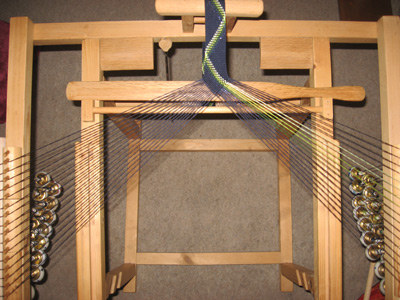
Meet my takadai. You see it here with its third braid in progress: a plain braid in cotton with the zig-zag pattern in a hope-filled array of spring-like green.
Even though this particular takadai has just been assembled and pressed into action, it already has a pretty long history. I bought it from a friend about a decade ago, then stashed it (still in pieces) in several carefully-labelled places. I actually got its parts out a few years back, but was too intimidated to put them together (having at that time never actually touched a real takadai with my own hands).
This month's "Any Dai" workshops changed all of that. :-) These workshops are offered annually as an outgrowth of The Braid Society. They take place at Aveton Farm in Devon and are mentored by Jennie Parry, an extraordinary braider with an eye for beauty and impeccable technique.
Even though I couldn't be there for the full five days, Jennie graciously set up a takadai for me to use, then provided handouts to lead me through many of the basics -- at an accelerated pace, as I had just the two days. It was amazing. Despite my initial clumsiness, each step built on top of everything that had come before in a wonderful, useful, logical fashion.
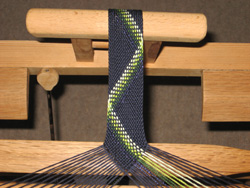
As soon as I got back home I found all the pieces of my own takadai, and (armed with knowledge of how the bits fit together) finally got it assembled. The very first warp snagged on everything -- the takadai needed sanding. Everywhere. So after the first warp, I sanded. After the second warp, I sanded some more. One by one, the snaggy parts disappeared. And then -- braiding bliss!
So, you may ask -- what is a takadai, anyway?? Here's the brief answer: the takadai is one of several traditional Japanese braiding stands. To our Western eyes, it provides a very 'weaverly' way of braiding; and many of the device parts and braiding movements have been given weaving-like names. But make no mistake: this is truly braiding, not weaving.
To get ever-so-slightly technical, in braiding, all the elements (threads, or groups of threads) are interlaced obliquely -- and if you click on the detail photo (right), you can see that. The threads travel diagonal paths. The structure is a biais structure.
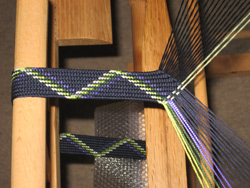
As with other thread-based endeavors, when you use more threads, you have more options for structure; and with more structural choices, you have a larger selection of patterns. The relationship between structure and pattern has always fascinated me. Here in the Land of Takadai, I feel surrounded by riches. :-)
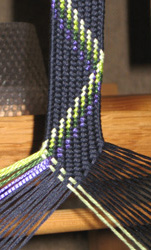
This braid-in-progress (left, viewed from the side rather than from the top) uses the same number of bobbins as the plain braid above (33 bobbins, for those who want to know) -- but the elements have a 'twill' interlacement. If you look at the threads, you can see the colour arrangement is similar to the one shown above (with a touch of purple added for Easter); but despite the similarities, the way the pattern appears in the braid is different, and the braid itself is more compact and has a denser feel.
I am totally in love.
The structures I've braided since my return have been very basic because I needed debug and de-burr the equipment -- but also because I had a real need to refine my braiding technique. To braid on a takadai, you open the pathway through which each bobbin passes by rippling your hand through the threads (very satisfying!) -- then you prop that pathway open, cast the bobbin through and beat the threads into place. It's lovely and graceful when an experienced braider does it. I am not lovely and graceful -- but I'm working on it.
But as I braid, I'm also having visions of pattern, fibre and texture: ripples of handspun, variegations on a solid ground, shining blocks of silk on a matte sea -- it's going to be a grand year. :-)
30 March 2013
Waiting for spring
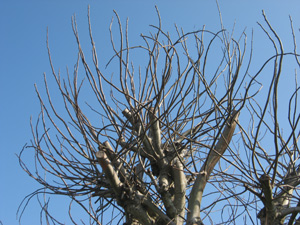
We finally have a bit of sunlight here, just in time to change our French clocks to 'summer time' -- but believable signs of spring are still a long ways off.
March has been a quiet month here, mostly. Granted, I was away from home for the Spring Knitting & Stitching Show in London (and a wonderful thing that was!) -- and after that I underwent a joyfully intensive two-day introduction to the takadai; and as you know, I'm often absent from this webpage when I'm absent from home. But I've also been slowed by some equipment problems.
First, my belt sander has been acting strangely and has not been allowing its belt to center properly. I normally would just ignore this, but the problem has a nasty tendency to strain the motor, and even bind the mechanisms so completely that the sander stops -- both of which I can't just ignore.
Most of the time, an equipment problem like that would have been taken care of within a day or two of its showing up (I am fond of my tools and try to take care of them); but another equipment problem hit me at the start of the month, and the remedy for that one has been slow in coming.
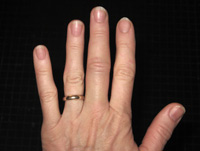
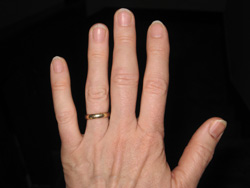
In the first photo (left), you see the problem just a few days after it appeared. I had jammed the middle finger of my left hand. That's jammed, as in bruised the joint and maybe cracked something. It hurt. A lot.
In the second photo (right), you see the hand as it looked this morning. Granted, you can't tell a whole lot from the outside -- but it now just feels arthritic instead of broken, and I'm profoundly grateful for that!
Awaiting the progress of spring, the appearance of more buds on the bare branches outside, a bit of warmth from this sudden burst of sunlight -- and more healing.
08 March 2013
Colourful interlude
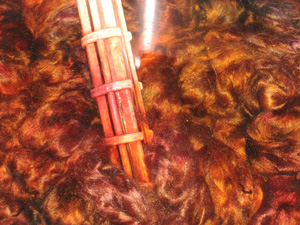
Isn't it lovely?? That's what the Copper silk looks like in the dyepot. The tones are rich and sensual, and I think it's perfectly obvious why it's one of my favourite colours to dye.
It's a fairly complex colour. The basic colour requires precise proportions of three different dyes. Partway through the 'cooking' process, the colour gets nuanced with a series of carefully-applied highlights and shadows. From start to finish, it's a challenge and a pleasure.
Things are rolling again, as you can see, and the dyepot burbles its way steadily through the week. Each day brings new delights and occasional surprises, and it follows a comfortable rhythm.
Even though I like to keep an array of silk colours on hand, everything happens here on a small scale. I dye in small batches, usually just 100 grams at a time. First I'll weigh out the silk, then it goes into a plain-water bath to soak. By the time one batch's worth is thoroughly wetted, the previous batch (in full colour) is cool enough to remove from the dyepot for its wash and rinse (which can sometimes take a while). After the final rinse, the silk is hung up to dry.
It's a pleasing cycle. Each day brings a fresh set of colours and adds a few more swags of drying silk to the rack in my laundry room -- a magically draped forest of colour.
Eventually when the silks are all dry, they can be weighed out into "bumps" destined for the central silk bag. That's a pleasure, too, especially on days when the light is good -- even when it's rumpled from the dyepot, silk shimmers and gleams.
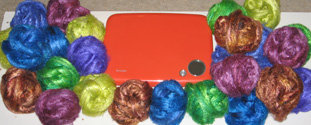 The little balls of silk top looked so joyous next to my digital scale, they were really irresistible… (not the most stunning photo, perhaps, but I loved all the contrasts).
The little balls of silk top looked so joyous next to my digital scale, they were really irresistible… (not the most stunning photo, perhaps, but I loved all the contrasts).
I like thinking of days being measured out in colours. If Monday is blue (in three different tones), then Tuesday must emerge into green, chartreuse and yellow -- unless, of course, it prefers a different direction and cloaks itself in purple, red and copper. What does the colour of the day say about its potential? What does the day itself do to suggest one tone rather than another? Could colour ever be forecast in the same way as weather, or eclipses, or seasons?
Days and colours and silk. Life is good. :-)
03 March 2013
Escaping the winter blues

For many people, winter is the time for companionship, cocooning, contemplation, carols, cocoa and cognac. It's true that it's all those things -- but it's also dark.
It's not my best season. Even when I was young, winter was a struggle; but as the years have ticked past, the darkness seems to have gained mass -- if darkness can have mass. In any case, it now feels a lot harder to shift. ...As winter set in a few months ago, I decided I wanted to experience it in a better light -- so I bought a special lamp. Its light is bright blue. It's meant to chase away the seasonal shadows.
There are no signs of spring yet in the gardens outside, but the days are longer, and I can feel the increasing day length; so the time has come to assess whether or not the magical lamp did its job.
I think it did! True, I didn't accomplish a lot of things this winter -- but I didn't plunge to the depths of the abyss, either. That's success enough for me. :-)
On a different note, I've just now returned from a visit to family in the States, and I thought I'd share one of the surprises I found there (right). It was in an antique store, mingled with 'vintage' belts in brightly coloured patent leather, rough macramé, tooled leather and hammered metal. It was labelled as "A Turkish Belt" -- and its price was $6.00.
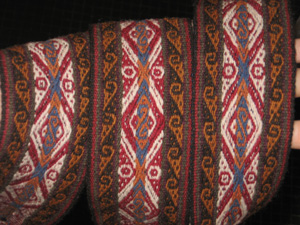
One end has been cut and hemmed, but the other shows the first few picks thrown by the weaver to make sure the warp was properly arranged. That end is finished with simple braids which give a nice peek at the yarns. The yarn is plied and appears to be commercially spun, and though I can't identify its fibre content, I'm guessing it's a wool blend -- the cloth doesn't have the density you'd expect in an all-alpaca Peruvian weaving, and in fact, has a certain springiness that I associate with acrylic....
Did it come from Peru?? Maybe. The designs are definitely among those you see from the Peruvian highlands -- but many of us have seen and loved those designs, and in appreciation, used them in our own weavings; so it could have been woven anywhere.
One thing is certain: it was woven by hands, not by an industrial machine. Another is true, too: it's nicely done.
Return to the Archive directory page
Return to the Now spinning page
